
![Ver [Norsk Heraldisk Forening] en instituciones citadas. Fortaleza de oro y mazonada de sable.](../css/Fortaleza.Institucion.png)
Norsk Heraldisk Forening
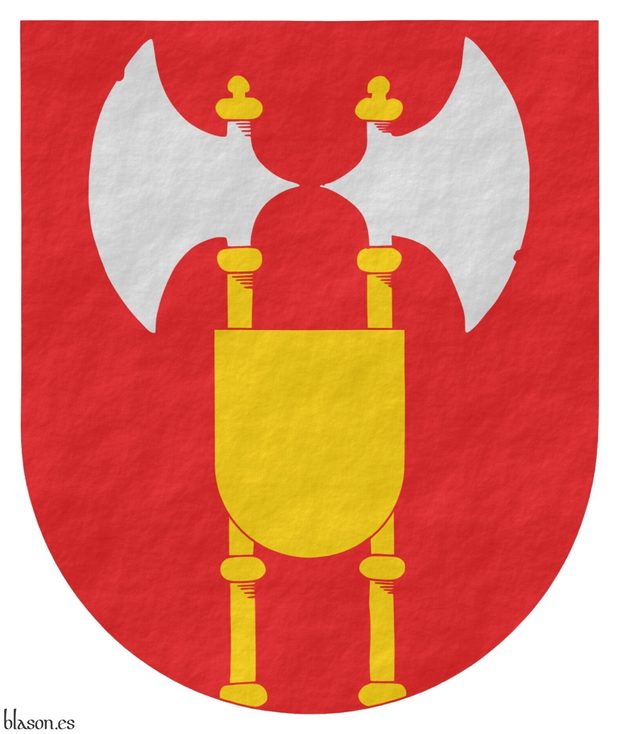
Norsk Heraldisk Forening, in English, Nordic Heraldry Society, was founded on February 27, 1969, at the National Archives in Oslo, with the aim of promoting the study and knowledge of heraldry through meetings, lectures, excursions, and other dissemination methods, and additionally, to become an advisory body to resolve issues in matters of heraldry, flags, personal coats of arms, etc. Its first president was Dr. Philos Herman L. Løvenskiold.
Since then, these have remained the objectives of the Norsk Heraldisk Forening, and its membership count has remained between 150 and 200 members, and it cooperates with the Nordic Heraldry Society, «Societas Heraldica Scandinavica».
The website's address is Heraldikk.no, its content is available in both Norwegian and English, and they work systematically to expand it and provide greater and better information to both its members and those interested in heraldry.
Blazon
Alex Maxwell Findlater described it in English, including its crest, in an article that was on their previous website under the title «About the society», as follows: «Gules issuant from base two battle-axes addorsed Argent shafted Or overall at the nombril point an escutcheon Or; for Crest between two axes of the arms a panache of three peacock feathers proper; Mantling Gules doubled Or». But given that «shafted» applies to weapons with a shaft and «hafted» to weapons with a handle, in the case of axes, I use «hafted» although both terms correspond to the Spanish «fustado».
Note how the axes are described as battle-axes, just as in the blazon of the Norwegian coat of arms, where its lion holds a battle-axe.
Coat of arms I attempted to interpret in the Norwegian style, all in flat tinctures, without Sable outlines, lighting or shading, and only with a simple rough finish.
Categories: Institution, Interpreted, Socioeconomic, Semi-circular, Plain tincture, Outlined in the field tincture, Rough, Coat of arms, Without divisions, Gules, Axe, Argent, Hafted, Or, Addorsed, Issuant from base, Overall, At the nombril and Escutcheon.


Norsk Heraldisk Forening, coat of arms
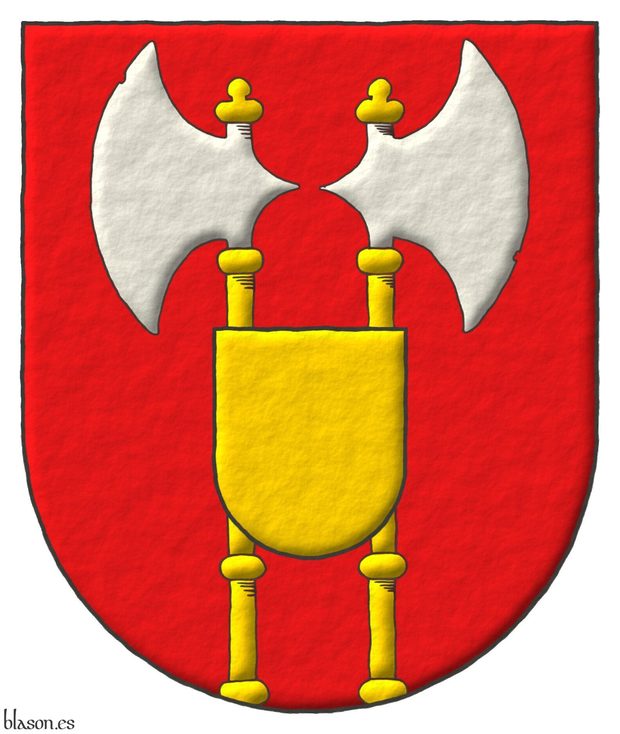
Gules, two axes addorsed Argent, hafted Or, issuant from the base; overall, at the nombril, an escutcheon Or.
Escudo de gules, dos hachas adosadas de plata, fustadas de oro, movientes de la punta; brochante sobre el todo, en el ombligo, un escudete de oro.
Interpretation I have made with the following characteristics: the escutcheon is semicircular, in the classic Castilian style; its field is illuminated with the tincture gules; its 2 axes and escutcheon are outlined in sable and illuminated with the metal Or, and the axe heads in Argent; and the execution is in a raised line style.
Hafted or shated
The term «hafted» in English is specifically used for weapons with handles, such as axes and hammers. This refers to the part of the weapon where the user grips, which is typically made of wood or metal and is essential for wielding the weapon effectively. The haft is integral to the weapon's function, providing the necessary leverage and control during use.
On the other hand, «shafted» is a term used in English for weapons with a shaft, which is a longer, slender part of the weapon, as seen in spears, arrows, and sometimes in lances. The shaft is usually the primary structural component, providing the length and reach, while also serving as the backbone of the weapon.
In both cases, the term indicates that this part of the weapon is of a different tincture from the rest of the figure.
In Castilian, however, both «hafted» and «shafted» translate to «fustadas», which broadly refers to a similar concept where the handle or shaft is of a different color than the head or blade.
Then, I prefer using «hafted» when referring to axes and hammers due to the specificity of the term in English.
This contrasts with the term «guarnezidas» ~ «hilted», which is used for swords, indicating a different color for the guard or hilt, rather than for the shaft or handle.
Addorsed, back to back
For the arrangement of the axes in relation to each other, the one on the dexter facing dexter, the one on the sinister facing sinister, I use the term «addorsed» as it is the most common, but I previously used «back to back», which is said of «two animals, rampant, with their backs against each other, each facing the opposite flank. Two keys are also described as back to back when they are positioned with the bits outward, each to its side; the same applies to sickles, or scythes and generally to all long objects that have two faces, like two axes...» [Avilés, J.; 1780a; page 98], this being the case for the axes in this shield.
«Dalla» is a synonym for «scythe» used in and originating from Aragon and Navarra, [Real Academia Española; 2001].
In the English blazon, «adosadas», «de espaldas», is rendered as «addorsed», from the French «adossé», which is said, for example, when «two animals turned back to back» and some also use «endorsed».
Blazon keywords: Without divisions, Gules, Axe, Argent, Hafted, Or, Addorsed, Issuant from base, Overall, At the nombril and Escutcheon.
Style keywords: Semi-circular, Illuminated, Outlined in sable and Freehand.
Classification: Interpreted, Socioeconomic and Coat of arms.
Bearer: Norsk Heraldisk Forening.

Nhf, Norsk Heraldisk Forening
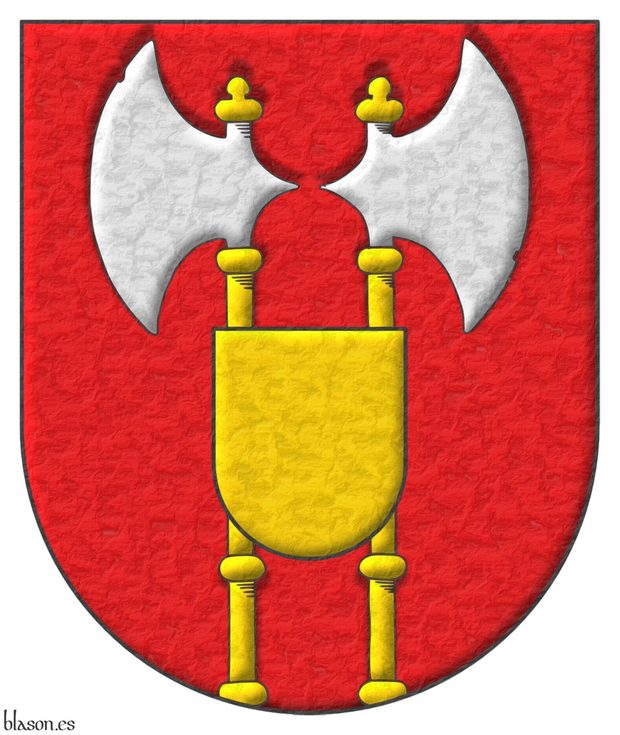
Gules, two Axes Argent, hafted Or, addorsed, issuant from the base; overall, at the nombril, an Escutcheon Or.
Escudo de gules, dos hachas adosadas de plata, fustadas de oro, movientes de la punta; brochante sobre el todo, en el ombligo, un escudete de oro.
Coat of arms interpreted with: the semicircular shape; its field illuminated with Gules; its figures and escutcheon illuminated with Or and Argent and outlined in Sable; and with a free hand texture.
At the nombril
A distinctive feature of this coat of arms is that its escutcheon, instead of being overall in the center, is positioned on a point of the coat of arms called the nombril, which, as we learn from [Avilés, J.; 1725a; page 159 and illustration 19] and also [Avilés, J.; 1780a; pages 147 and 148], in «Heraldry, the nombril of the coat of arms, is the place through which the human body receives nourishment in the mother's womb, and in the shield, it corresponds to the point where the fess ends and the base begins.».
If this escutcheon, «escudete» in Castilian, had been positioned in the center of the coat of arms, then it would have to be blazoned as the piece called an inescutcheon, «escusón» in Castilian. In fact, the Norsk Heraldisk Forening uses the English term «escutcheon» to describe the blazon of its arms.
Blazon keywords: Without divisions, Gules, Axe, Argent, Hafted, Or, Addorsed, Issuant from base, Overall, At the nombril and Escutcheon.
Style keywords: Semi-circular, Illuminated, Outlined in sable, Shaded and Soft metal.
Classification: Interpreted, Socioeconomic and Coat of arms.
Bearer: Norsk Heraldisk Forening.


This site does not use cookies
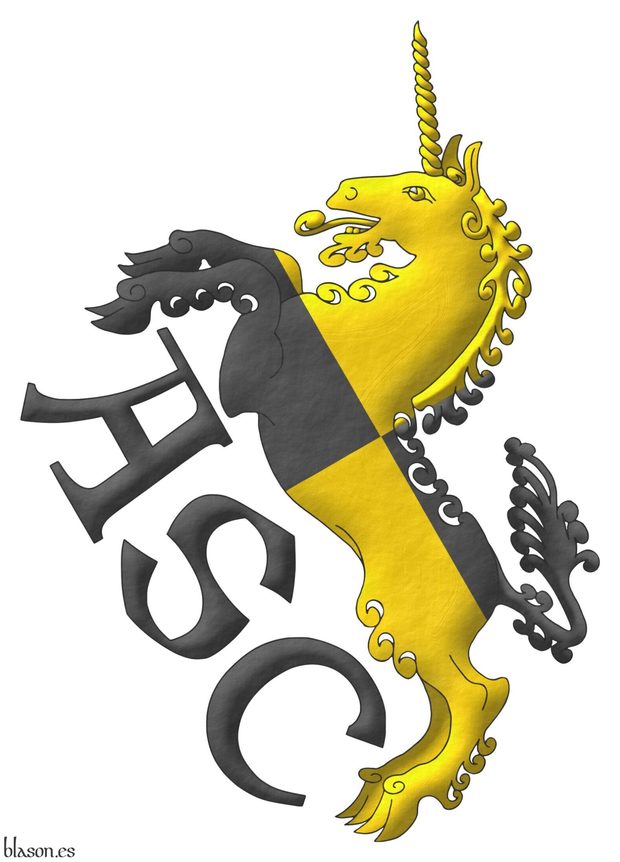
Neither own nor third party cookies
The owner of Blason.es does not register any personal data from the users through the well-known «cookies», neither own nor third party, neither session cookies nor technical cookies.
The domains listed in associated heraldry domains do not use «cookies» either.
In a future, only for statistic purposes
This site has no «cookies», but if any day «cookies» were instaled in Blason.es, the legally relevant notice would be issued. In any case, this would only be to record basic data of navigation, such as the device class (computer, mobile, tablet, etc.), the type of device browser and its version or the type of operating system the user has, without user identification and only to statistical effects and in order to improve the location of the contents and the quality of this site Blason.es and its associated heraldry domains.


Lucius III
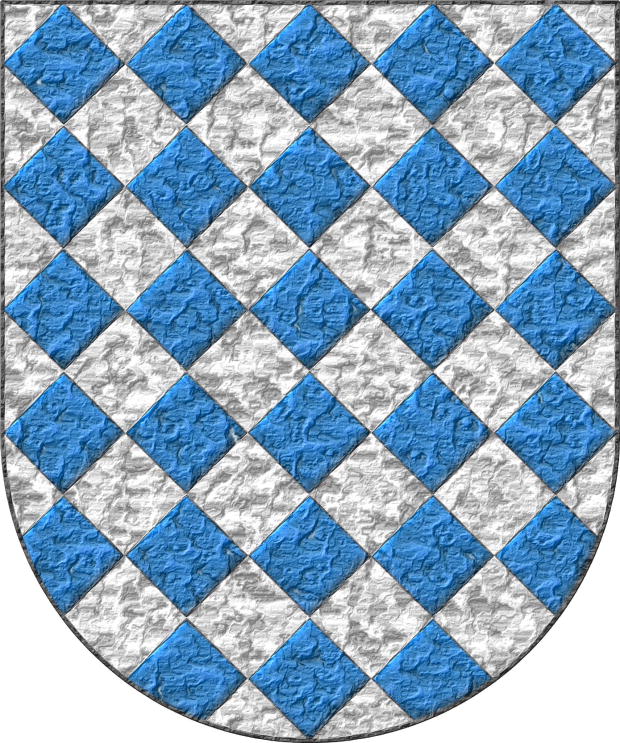
171st Pope of the Church, from the year 1181 to the year 1185. «Lucius III», born Ubaldo Allucinoli, was born in Lucca in northwest Italy.
Lozengy Argent and Azure.
Escudo losanjado de plata y azur.
Papal coat of arms interpreted by me with: a semicircular shield shape; a plain Argent field; checky or squares illuminated in Azure and outlined in Sable; and the whole design with a watercolor finish.
Blazon keywords: Without divisions, Lozengy, Argent and Azure.
Style keywords: Semi-circular, Illuminated, Outlined in sable and Hard metal.
Classification: Interpreted, Religious and Papal States.
Bearer: Lucius III.


Innocent IV
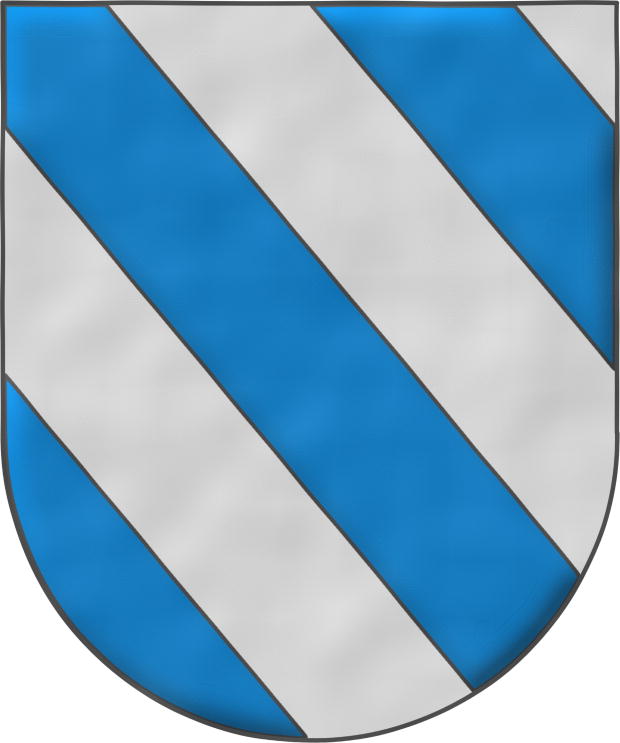
180th Pope of the Church, from 1243 to 1254. «Innocentius IV», born Sinibaldo dei Fieschi, was born in Manarola in northwest Italy.
Bendy of six Azure and Argent.
Escudo bandado de seis piezas de azur y plata.
Papal coat of arms interpreted by me with: a semicircular shield shape; a plain Argent field; bands illuminated in Azure and outlined in Sable; and the whole design with a watercolor finish.
Order of tinctures
In the bendy pattern, the tinctures are named starting from the one located at the dexter base of the shield and following an ascending sequence towards the sinister chief, although the most orthodox approach is to have only 2 tinctures, being one color and one metal.
Number of bands
It is said that it is not necessary to specify the number of bands when there are precisely 6, as in this case, and that it should be specified when there are, for example, 4 or 8. I have chosen to specify it for greater clarity of the blazon.
About the bendy pattern and the need to specify or not specify the number of its pieces, [Avilés, J.; 1725a; pages 40 and 41] and [Avilés, J.; 1780a; pages 45 and 46] say that it is «composed of four, six, or eight bends; in such a way that there are as many colors as metals, always specifying the number four and eight bands when blazoning, and not the one composed of six, as it is understood thus, without declaring the number of pieces» and without agreeing with it, and by its wording I believe that he is not entirely in agreement either, he adds «the reason that may exist for not specifying the number of six bends (although the authors do not express it) is that as the bend is one-third of the shield; and having six pieces, or six bends, the resulting number is doubled, as if the three parts were divided, which implies that the shield is filled with three bends; and taking the denomination of the figure infers, that the bendy is of six pieces: which does not happen with this equality in those of four and eight, requiring other proportions and consequently it becomes necessary to specify their number», therefore, note that the bendy of 6 does not follow the proportions of the bend, nor do those of 4 or 8, the only differential property of the one of 6 is being a multiple of 3, being 1/3 the width of the bend.
Blazon keywords: Without divisions, Bendy, Six, Azure and Argent.
Style keywords: Semi-circular, Illuminated, Outlined in sable and Watercolor.
Classification: Interpreted, Religious and Papal States.
Bearer: Innocent IV.


Urban IV
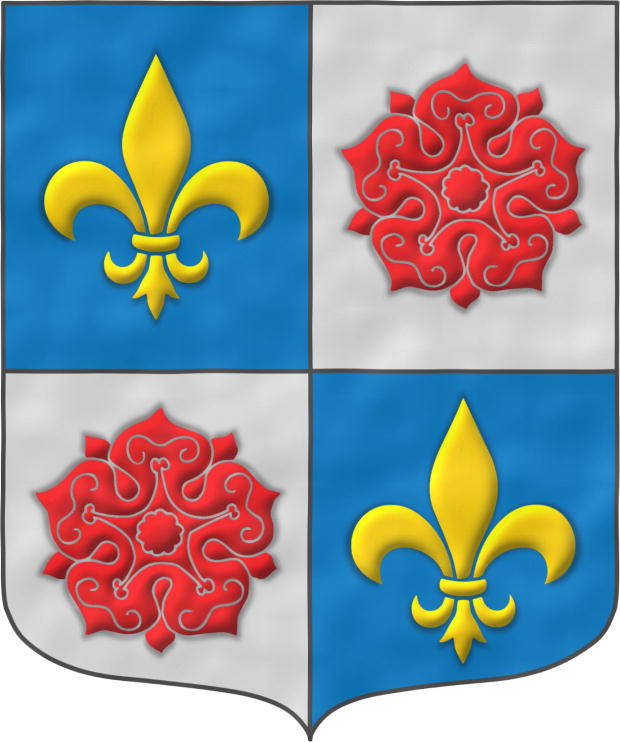
182nd Pope of the Church, from 1261 to 1264. «Urbanus IV», born Jacques Pantaleon of Court-Palais, was born in Troyes, France.
Quarterly: 1 and 4 Azure, a fleur de lis Or; 2 and 3 Argent, a rose Gules.
Escudo cuartelado: 1o y 4o de azur, una flor de lis de oro; 2o y 3o de plata, una rosa de gules.
Coat of arms of Urban IV with: a pointed and rounded shield shape; the field in plain Azure and Argent enamels; the figures outlined in the field, shaded and illuminated in Or and Gules; and with a watercolor finish.
Blazon keywords: Quarterly, Azure, One, Fleur de lis, Or, Argent, Rose and Gules.
Style keywords: Pointed and rounded, Illuminated, Shaded, Outlined in the field tincture and Watercolor.
Classification: Interpreted, Religious and Papal States.
Bearer: Urban IV.

Sigue por: Gregory X.
-
Language
-
Categories of heraldry
-
Divisions of the field
- Without divisions
- Party per pale
- Party per fess
- Party per bend sinister
- Tierce
- Tierce sinister
- Tierced per bend
- Tierced pallwise inverted
- Quarterly
- Quarterly per saltire
- Gyronny
- Party per fess, the chief per pale
- Party per pale, the sinister per fess
- Party per fess, the base per pale
- Party per pale, the dexter per fess
- Party per chevron
- Enté en point
- Flanched
-
Metals
-
Colours
-
Furs
-
Other tinctures
-
Ordinaries and sub-ordinaries
-
Diminutives of the ordinaries
-
Other charges
-
Charges from Nature
Water, Eagle, Bald eagle, Eagle claw, Dorsal fin, Tail fin, Two hands clasped, Lark, Tree, Trunk, Rainbow, Atom, Barbel, Acorn, Bighorn sheep, Arm, Owl, Vulture, Horse, Head, Camellia, Thistle, Merino ram, Kapok tree, Stag, Doe, Crescent, Increscent, Tail, Tail addorsed, Ermine spot, Hummingbird, Heart, Roe deer, Neck, Roe deers' attires, Raven, Dolphin, Diamond, Tooth, Elephant, Emerald, Starling, Mullet, Mullet of four points, Star of David, Estoile, Male figure, Fleur de lis, Lotus flower, Hop cone, Puffin, Ash, Rooster, Claw, Talon, Goose, Heron, Seagull, Pomegranate, Sunflower, Falcon, Leaf, Boar, Goldfinch, Laurel, Barn owl, Lion, Lioness, Lion passant, Leopard, Lion rampant guardant, Lynx, Lily, Madonna lily, Flame, Wolf, She-wolf, Moon, Bluebonnet, Hand, Apple, Apple tree, Martlet, Wing, Two wings in vol, Covert, Mount, Trimount, Fly, Wrist, Elm, Olive tree, Orbital, Bear, Palm frond, Palm tree, Dove, Poplar leaf, Jaguar, Paw, Forepaw, Peacock, Chest, Pelican, Pelican in her piety, Dog, Brach hound, Fish, Hoof, Beak, Quill, Cinquefoil, Quetzal, Branch, Sprig, Shamrock, Caboshed, Oak, Holm oak, Rose, Double rose, Savage, Serpent, Sun in splendour, Ray of the sun, Stem, Badger, Tyger, Wheat, Wheat spike, Bull, Tulip, Udder, Escallop and Fox.
-
Artificial charges
Halberd, Plough share, Ace of spades, Anchor, Cyclamor, Torch, Arch, Harp, Non-classic artifact, Winnowing fan, Crozier, Pair of scales, Ship, Beret, Grenade, Ecclesiastical cap, Arm vambraced, Chain, Covered cup, Bell, Bell tower, Cannon dismounted, Carbuncle, Castle, Clarion, Nail, Cord, Dagger, Key ward, Turret, With a turret, Armillary sphere, Sword, Sabre, Parchment, Scroll, Arrow, Club, Garb, Gauntlet, Axe, Buckle, Galician granary, Polish winged hussar, Church, Oil lamp, Spear, Spear's head, Fleam, Letter, Book, Closed book, Open book, Bookmark, Page, Line, Key, Four crescents joined millsailwise, Hammer, Menorah, Mortar, Pestle, Number, Knot, Celtic Trinity knot, Water-bouget, Comb, Piano, Millstone, Millrind, Millwheel, Clay pot, Bridge, Cuffed, Hourglass, Chess rooks, Compass rose, Rosette of acanthus leaves, Mullet of six points pierced, Broken, Portcullis, Wheel, Wagon-wheel, Symbol, Sackbut, Drum, Tower, Trident, Trumpet, Double vajra and Anvil.
-
Immaterial charges
Angel, Heart enflamed, Sacred Heart of Jesus, Paschal lamb, Dragon, Wyvern, Phoenix, Garuda, Griffin, Sea-griffin, Winged hand, Our Lady of Mercy, Pegasus, Saint George, Mermaid, Trinity, Triton, Golden fleece, Unicorn and Ouroboros.
-
External elements
-
Heraldic creations
-
References
-
Formats
-
Keywords on this page
Watercolor, Addorsed, Embattled, Pointed and rounded, Azure, Bendy, Overall, Quarterly, Outlined in sable, Outlined in the field tincture, At the nombril, Escutcheon, Coat of arms, Papal States, Fleur de lis, Hafted, Gregory X, Gules, Axe, Illuminated, Innocent IV, Institution, Interpreted, Chief, Legal notice, Lozengy, Lucius III, Marmoreal, Semi-circular, Hard metal, Soft metal, Issuant from base, Norsk Heraldisk Forening, Or, Argent, Without divisions, Privacy policy, Religious, Rose, Rough, Six, Socioeconomic, Shaded, Plain tincture, Freehand, One and Urban IV.